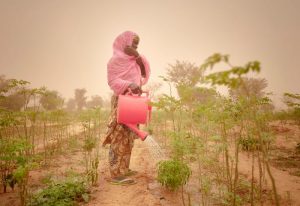War, drought brings hunger to Ethiopia
A prolonged drought in the Horn of Africa which has come hard on the heels of a brutal civil war has brought life-threatening food shortages to Ethiopia.
The UN Refugee Agency UNHCR has said five failed rainy seasons since 2019 across the region have created a devastating drought that has affected millions of people, including refugees, in the region.
More than 120,000 Somali refugees have arrived in Ethiopia this year. Most are women, children, older people and people with specific needs, who arrive with nothing. Among them are a high number of unaccompanied and separated children, which heightens protection concerns.
UNHCR said water sources have dried up, crops and livestock have been decimated, and people’s capacities to support themselves have been eroded. 
Intensifying the hardship, food prices have rocketed, making it too expensive for most refugees and local communities to afford even basics.
“The inevitable result is rising malnutrition rates, particularly among women and children who often bear the brunt of food shortages,” the UNHCR statement said.
The drought and the war have rolled back advances in economic development and welfare made over the past two decades.
The growth was the result of Ethiopia’s ‘developmental state’ model, characterised by central planning and huge public investments.
At the same time, Ethiopia introduced protection schemes, including Africa’s second-biggest social safety net, which has given financial support to millions of food-insecure farmers since it started in 2005.
When Prime Minister Abiy Ahmed came to power in 2018, he sought to build on the model’s successes, while also liberalising parts of the economy and encouraging outside investment – all part of a longstanding national plan to achieve middle-income status by 2025.
Ethiopia set African records in poverty reduction.
But the progress has been stymied by advent of COVID-19 in 2020, followed by a devastating civil war between Abiy’s government and the leaders of Ethiopia’s northern Tigray region who once dominated national politics.
The fallout from the drought, which has hit southern and eastern Ethiopia particularly hard, has been exacerbated by a countrywide suspension of food aid by donors last month, following revelations of a major food theft scheme in which federal and regional governments are implicated.
The result is that 20 million people in Ethiopia who rely on food aid – about a sixth of the population – are facing hunger.
A global spike in food and commodity prices caused by the Ukraine war, and ongoing insecurity in Amhara and Oromia, Ethiopia’s two most populous regions – have also led to rising prices.
An analysis by the United Nations Development Program (UNDP) said “rates of poverty… have increased in all regions compared to 2015/16”.
The spike in poverty has been worst in war-affected areas, and in towns and cities where previous poverty reduction efforts had been most successful, the report said.
In the capital Addis Ababa, the poverty rate has risen from 17.8 per cent to 24 per cent between 2016 and 2022, according to the report.
The agency estimated the number of people living in poverty in Tigray rose from 27 per cent to 45 per cent over the same period.
The UNDP said the conflict in northern Ethiopia caused $22.7 billion worth of damage to infrastructure and a further $6 billion of productivity losses – equivalent to 26 per cent of GDP – between November 2020 and December 2021.
It said agriculture was the hardest hit sector, sustaining 59 per cent of the war losses – the result of looting, interruptions to planting, the killing of livestock, the looting of crop harvests and vandalism.
Hospitals, schools, and other social infrastructure accounted for 21 per cent of the damage.
The war, which ended with a ceasefire in November 2022, is reported to have tipped three million people into poverty across northern Ethiopia.












